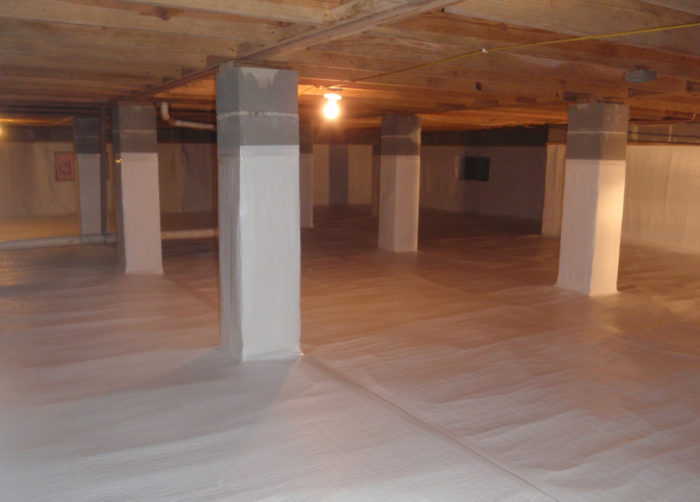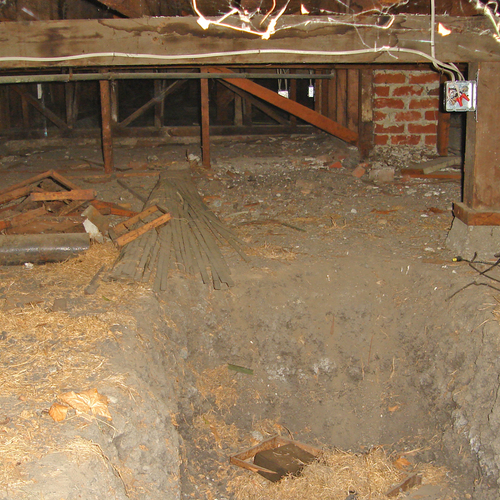
Clean and dry
This crawl space has been sealed to prevent air leaks and energy losses. Polyethylene sheeting on the floor is an effective moisture barrier.Image Credit: GBA
Morgan Martin’s dilemma is what to do about the crawl space beneath the house, identified in a recent energy audit as a source of air leaks and energy loss.
The joist bays above the crawl space have been insulated with fiberglass batts, but the subflooring has not been air-sealed. A local green building company recommends removing the batts and taping and caulking all the gaps in the floor (that is, the crawl space ceiling). Once that’s accomplished, the builder lists three options:
- Put the fiberglass batts back in place with no additional insulation;
- Apply rigid polystyrene insulation, then reinstall the fiberglass batts; or
- Forget the fiberglass and spray BASF Spraytite closed-cell foam on the underside of the floor sheathing.
There are two complications: “Please know before I go on that I have chemical sensitivity issues,” Morgan Martin writes in this Q&A post at GreenBuildingAdvisor , “so this is why this decision is such a big deal for me.”
There’s also a concern about rats. The crawl space had been infested with them, and while it’s since been cleaned and sealed, Morgan questions whether the polyethylene sheeting that covers the dirt floor will be enough to keep them out in the future, and that may affect whatever option he chooses.
But the main issue seems to be the potential health effects of polyurethane foam, discussed in a number of previous Q&A posts. “We have the option of doing a 2-in. layer of the foam and then putting the fiberglass back up over it or doing a 4.5-in. layer and not using the fiberglass at all,” Morgan says. “Even with all this reassurance it will be safe for me and my family, I have severe reservations about using the spray foam — even though the green builder…
Weekly Newsletter
Get building science and energy efficiency advice, plus special offers, in your inbox.

This article is only available to GBA Prime Members
Sign up for a free trial and get instant access to this article as well as GBA’s complete library of premium articles and construction details.
Start Free TrialAlready a member? Log in















5 Comments
Crawl space venting & insulation details
The "CleanSpace" system of crawl space encapsulation, developed by Connecticut-based Basement Systems, has achieved an impressive track record for turning damp, pest-infested, energy inefficient crawl spaces into clean, conditionted, energy-efficient areas. This system is designed to handle worst-case crawl space scenarios, with a perimter drain and sump pump system to remove water, a super-durable plastic moisture barrier to seal the dirt floor, and both spray and rigid foam to insulate and air-seal the foundation walls. There's even a gasketed, PVC cover that completely seals crawl space vents and doors. It's worth checking out if you want to see a well-designed, state-of-the-art system.
Location is essential for determining insulation placement!
Responding particularly to Martin, Peter and Hansen, I would add that in cold climates, sealed-insulated crawlspaces with insulation applied to the foundation walls have been shown to use much more energy for heating than their counterparts with crawlspace ceiling insulation. The reason was due to massive radiative heat losses from the exposed crawlspace ceiling to the cool earth. They found a 20% heating energy savings compared with a control group (code-compliant, presumably vented, r-19 batts in ceiling) for the R-30 fiberglass batts (crawl still sealed), and a 53% increase in heating energy use compared with a control group for the R-13 continuous foam on the foundation walls. Of course, were these r-values equal, the story might be different, but it is rare to retrofit r-30 foam on crawlspace walls. This research was done in Flagstaff, AZ, with ducts in the crawl. Of course, one would expect cooling energy use to react inversely. Here's an overview of the research done by Advanced Energy Corp: http://www.advancedenergy.org/buildings/knowledge_library/crawl_spaces/pdfs/Closed%20Crawl%20Spaces.pdf
So, this has nothing to do with the question of health/toxicity (sealed crawls performed much better in terms of moisture/mold in the above study), but I think that the choice of insulation placement is heavily dependent on climate/location. It is simply not true to insulating the foundation walls and sealing the crawl will save energy in all cases.
You are all still missing the point...
To get the benefits of lower energy bills AND a cleaner dryer crawl space, you need to insulate the floor AND the crawlspace walls, and possibly the crawlspace floor, depending on your climate zone. So far as I have been able to verify, I am the only one who has been using this system, and I have been proving it's effectiveness for more than twenty years.
Responding to my response to his article on Closed Crawlspace design recently, Martin Holladay criticized my system as being too expensive for most, because it requires installing insulation in two places instead of just one. We have done the math, repeatedly, on every house we build that has a crawl space. That extra insulation pays for itself in three to five years, if my regimen is followed.
You can download my Closed Crawlspace Calculator for free at http://www.Zero-EnergyPlans.com. You will need to adjust the ground temperature and typical winter outside air temperatures for you own climate zone, you may also want to make other tweaks to make it work for you, as it was only originally intended for use in the Pacific Northwest. I have tried it using data from a number of locations through zones 3-6, and it works in all of them.
In this assembly, spray foam should be reconsidered.
One of the couple did stop by the Small Planet Workshop and we discussed a third option: Leaving the batt insulation in place and adding a permeable but airtight membrane spanning the bottom of the floor joists.
To me it seemed clear that the central issue was that there was no subfloor. The floor consisted of 2x6 T&G car-decking (as we call it in the Pacific Northwest), directly over the joists. This means to me that if the chemical sensitivity does occur after the product is applied, then there is quite a problem since the T&G decking is really quite open for air movement and off-gassing. Once the SF product is there... There's no removing it. Good empirical data of successful application on projects for chemically sensitive is great... Until it's wrong for this client. Personally, I think the lack of sheet stock in this floor assembly suggests a cautionary approach for this project.
This approach was not chosen by the client since a taped membrane from Siga, Tyvek or other is not "rat proof" and if another infestation occurs it could be difficult to inspect membrane damage. Admittedly, the air-sealing details of the perimeter would be difficult but I don't think more so than any of the other strategies offered. What it does have is no VOC's in the Siga air-sealing tapes or membranes. Nothing to off-gas and an easy inspection and service addition for future changes.
I know the builder in this case and he's quite good. If foam is used, hopefully it doesn't trigger the client.
I have a client with a crawlspace, and the installed stopped the air sealing 3" of the Rim joist to have a Termite Gap as a termite control DE area. Is this important or a myth?
Please advise.
Log in or become a member to post a comment.
Sign up Log in